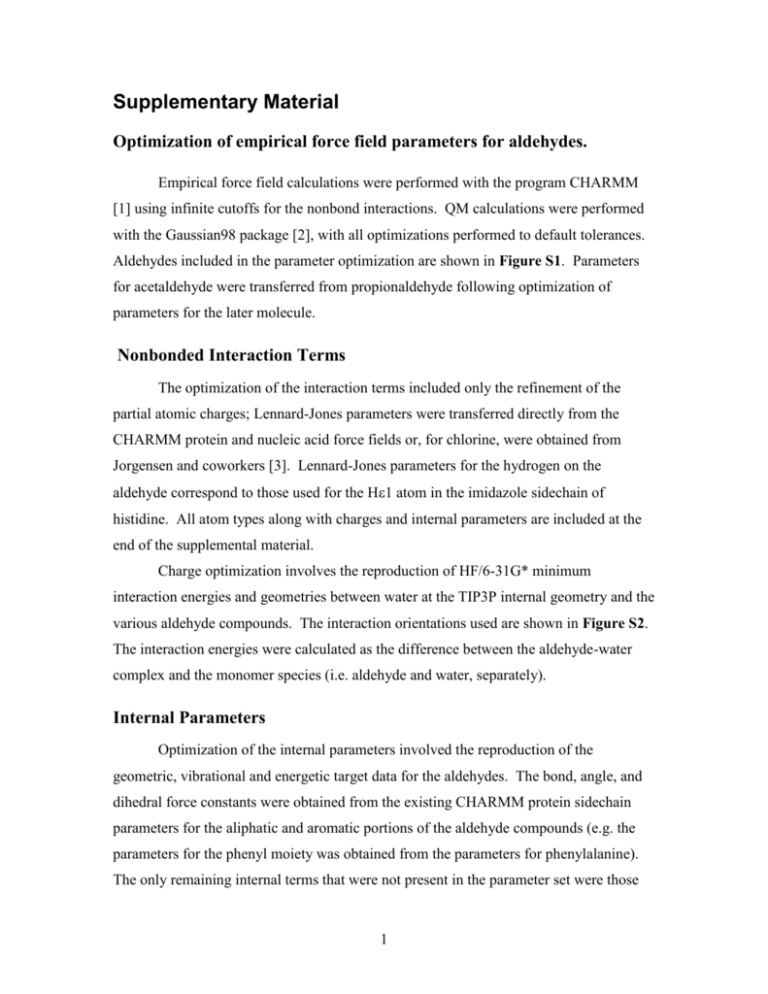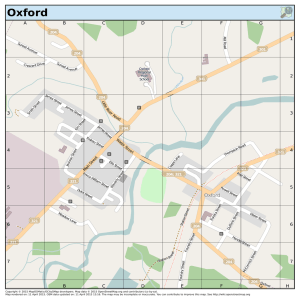Internal parameter optimization
advertisement

Supplementary Material Optimization of empirical force field parameters for aldehydes. Empirical force field calculations were performed with the program CHARMM [1] using infinite cutoffs for the nonbond interactions. QM calculations were performed with the Gaussian98 package [2], with all optimizations performed to default tolerances. Aldehydes included in the parameter optimization are shown in Figure S1. Parameters for acetaldehyde were transferred from propionaldehyde following optimization of parameters for the later molecule. Nonbonded Interaction Terms The optimization of the interaction terms included only the refinement of the partial atomic charges; Lennard-Jones parameters were transferred directly from the CHARMM protein and nucleic acid force fields or, for chlorine, were obtained from Jorgensen and coworkers [3]. Lennard-Jones parameters for the hydrogen on the aldehyde correspond to those used for the H1 atom in the imidazole sidechain of histidine. All atom types along with charges and internal parameters are included at the end of the supplemental material. Charge optimization involves the reproduction of HF/6-31G* minimum interaction energies and geometries between water at the TIP3P internal geometry and the various aldehyde compounds. The interaction orientations used are shown in Figure S2. The interaction energies were calculated as the difference between the aldehyde-water complex and the monomer species (i.e. aldehyde and water, separately). Internal Parameters Optimization of the internal parameters involved the reproduction of the geometric, vibrational and energetic target data for the aldehydes. The bond, angle, and dihedral force constants were obtained from the existing CHARMM protein sidechain parameters for the aliphatic and aromatic portions of the aldehyde compounds (e.g. the parameters for the phenyl moiety was obtained from the parameters for phenylalanine). The only remaining internal terms that were not present in the parameter set were those 1 involving the atoms of the aldehyde moiety. The geometries of the aldehydes were obtained from QM calculations at the MP2/6-31G* level of theory, and optimized by performing energy minimizations in vacuo with infinite cutoffs. The vibrational frequencies were calculated using the VIBRAN module, and the potential energy distributions were calculated using the MOLVIB module [4] in CHARMM. A scaling factor of 0.9 was used for QM HF/6-31G* frequencies [5] for empirical value comparison. The dihedral parameters were optimized to reproduce the QM energy barriers. Results and Discussion The CHARMM potential energy function has been optimized for a set of aldehydes: acetaldehyde, propionaldehyde, benzaldehyde, and chloroacetaldehyde (Figure S1). The optimization procedure was similar to previously described developments of the parameters for other biomolecules. The parameter set for the aldehydes was either optimized for agreement with QM calculations, or utilizing previously existing parameters when appropriate. An iterative procedure was employed, first optimizing the nonbonded parameters, then the internal or intramolecular parameters followed by reevaluation of the nonbond terms. Nonbonded Parameter Optimization The partial charges were optimized using the interaction energy surface at the HF/6-31G* level of theory. The minimum interaction energies and distances were derived using the interaction orientations shown in Figure S2. The polar-neutral compound charges were optimized to reproduce the QM aldehyde-water interaction energies and distances, scaled by 1.16 and offset by –0.2 Å, respectively, to yield acceptable condensed phase properties. The reasoning behind these values has been described elsewhere [6]. As shown in Table SI, the agreement between the empirical and QM data is generally quite good, validating the quality of the developed force field for the treatment of nonbond interactions with the protein environment. It should be emphasized that the selection of the HF/6-31G* level of theory for the QM calculations is performed to maintain consistency with the remainder of the CHARMM22 force field [7]. 2 Table SI) Minimum interaction energies and distances for the optimized empirical force field and the QM data for the aldehyde model compounds. Interaction Energies Empirical QM Propionaldehyde (0o) O---HOH O---HOH H---OH2 Propionaldehyde (120o) O---HOH O---HOH H---OH2 Chloroacetaldehyde O---HOH O---HOH H---OH2 Cl---HOH Benzaldehyde O---HOH O---HOH H---OH2 Interaction Distances Empirical QM -4.485 -2.654 -1.472 -4.490 -2.097 -1.469 1.85 2.69 2.36 1.86 2.52 2.42 -4.392 -5.149 -1.369 -4.540 -4.771 -1.420 1.85 1.84 2.37 1.86 1.85 2.43 -4.187 -4.823 -2.358 -0.097 -4.213 -4.711 -2.375 -0.192 1.85 1.84 2.28 2.43 1.90 1.88 2.20 3.25 -4.306 -1.658 -1.816 -4.523 -1.040 -1.568 1.85 3.08 2.35 1.86 2.75 2.42 Energies in kcal/mol and distances in Å. The HF/6-31G(d) QM calculated interaction energies and distances were scaled by 1.16 and offset by –0.2 Å, respectively. Internal parameter optimization Internal parameters were optimized to reproduce the MP2/6-31G* geometries, vibrations and conformational energies of the aldehyde moieties; the remainder of the internal parameters were directly transferred from the CHARMM22 force field for proteins. Shown in Tables SII and SIII are the empirical and QM bonds and angles, respectively, for the aldehyde moieties. Overall, the agreement between the empirical and QM data is satisfactory, indicating the internal aspect of the force field to yield reasonable geometries. The largest discrepancies are due to the use of common atom types for the aldehyde group in all four model compounds. For example, in acetaldehyde and propionaldehyde, the O-C bond is to long in the empirical model as compared to the QM target data, while the opposite is true to the O-C bond in chloroacetaldehyde and benzaldehyde. A similar trend occurs with the O-C-CB(CG) angle. Such differences 3 may be eliminated via the use of additional atom types. However, the small magnitude of the changes did not warrant such an addition in the present case Table SII) Comparison of the empirical and QM bond lengths for the aldehyde moieties on the model compounds. Bond Empirical QM Acetaldehyde HA-C 1.111 O-C 1.203 C-CB 1.516 Propionaldehyde HA-C 1.110 O-C 1.204 C-CB 1.530 Chloracetaldehyde HA-C 1.111 O-C 1.204 C-CB 1.519 CB-CL 1.777 Benzaldehyde HA-C 1.110 O-C 1.206 C-CG 1.489 Average Difference RMS Difference Bond lengths in Å 4 Difference 1.096 1.188 1.508 0.015 0.015 0.008 1.096 1.188 1.508 0.014 0.016 0.022 1.106 1.220 1.519 1.777 0.004 -0.016 0.001 0.000 1.110 1.227 1.480 -0.001 -0.021 0.009 0.005 0.013 Table SIII) Comparison of the empirical and QM valence for the aldehyde moieties on the model compounds. Angles Acetaldehyde HA-C-O HA-C-CB O-C-CB Propionaldehdye HA-C-O HA-C-CB O-C-CB C-CB-CG Chloroacetaldehyde HA-C-O HA-C-CB O-C-CB C-CB-CL Benzaldehyde HA-C-O HA-C-CG O-C-CG C-CG-CD1 C-CG-CD2 Average Difference RMS Difference Empirical QM Difference 121.0 116.5 122.5 120.2 115.0 124.8 0.8 1.5 -2.3 120.9 116.1 123.0 114.5 120.2 115.0 124.8 113.8 0.7 0.9 -1.8 0.8 121.0 116.4 122.6 111.9 122.5 116.5 121.0 111.8 -1.4 -0.2 1.6 0.1 120.8 114.4 124.8 120.8 119.8 120.5 115.2 124.3 119.9 119.7 0.3 -0.8 0.6 0.8 0.0 0.1 1.1 Angles in degrees. Force constants were optimized initially to reproduce vibrational spectra, with emphasis on the reproduction of both frequencies and assignments. Tables SIV to SVI show good agreement between the empirical and QM models. Notable is the quality of the low frequency regions, as those modes will typically have the largest displacements in MD simulations, thereby having the largest impact on the results from MD simulations. 5 Table SIV: Comparison of Empirical and Quantum Mechanical Vibrational Frequencies (cm-1) for Propionaldehyde. Mode Empirical Empirical assignments QM QM assignments 1 2 3 4 5 6 7 8 9 10 11 12 13 14 15 16 17 18 19 20 21 22 23 24 139.0 256.7 259.7 682.9 769.9 813.8 1007.0 1027.8 1079.8 1150.6 1256.3 1349.2 1408.7 1415.1 1428.8 1429.0 1438.2 1740.5 2900.3 2909.3 2917.4 2941.8 2959.1 2960.7 CC tor. CCC sciss. CC tor. OCC def. CH2 rock. CC str. CH3 rock. CH3 rock.' CC str. CH wag. CH2 twist CH2 wag. CH2 sciss. CH3 sym. def. CH3 asym. def. CH3 asym. def.' CH rock. CO str. CH3 str. CH str. CH2 str. CH2 str. CH3 str. CH3 str. 138.9 256.6 259.4 683.0 769.3 813.5 1006.9 1027.8 1079.8 1150.5 1256.6 1349.4 1408.5 1415.1 1428.8 1428.9 1438.3 1740.5 2900.2 2909.2 2917.4 2941.7 2959.1 2960.7 CC tor. CCC sciss. CC tor. OCC def. CH2 rock CC str. CH3 rock CH3 rock' CC str. CH wag CH2 twist CH2 wag CH2 sciss. CH3 sym. def. CH3 asym. def. CH3 asym. def.' CH rock CO str. CH3 str. CH str. CH2 str. CH2 str. CH3 str. CH3 str. 6 Table SV: Comparison of Empirical and Quantum Mechanical Vibrational Frequencies (cm-1) for Chloroacetaldehyde. Mode Empirical Empirical assignments QM QM assignments 1 2 3 4 5 6 7 8 9 10 11 12 13 14 15 7.6 321.9 498.3 807.0 831.5 1032.6 1128.8 1257.4 1349.2 1419.7 1486.5 1733.6 2868.8 2902.4 2913.0 CC def. CCCl sciss. OCC def. CH2 rock. CCl str. CC str. CH wag. CH2 twist. CH2 wag. CH rock. CH2 sciss. CO str. CH2 str. CH2 str. CH str. 3.8 261.3 441.5 687.5 798.2 1005.3 1015.5 1160.0 1257.1 1360.9 1423.3 1685.4 2862.7 2975.2 3038.1 CC tor. CCCl sciss. OCC def. CH2 rock. CCl str. CH wag. CC str. CH2 twist. CH2 wag. CH rock. CH2 sciss. CO str. CH str. CH2 str. CH2 str. 7 Table SVI: Comparison of Empirical and Quantum Mechanical Vibrational Frequencies (cm-1) for Benzaldehyde. Mode Empirical Empirical assignments QM QM assignments 1 2 3 4 5 6 7 8 9 10 11 12 13 14 15 16 17 18 19 20 21 22 23 24 25 26 27 28 29 30 31 32 33 34 35 36 88.7 229.4 239.8 404.2 414.4 472.4 621.4 651.3 691.6 768.9 786.0 882.3 951.2 953.2 975.6 1000.9 1024.0 1024.8 1036.5 1144.2 1211.5 1219.0 1352.5 1387.2 1425.9 1440.4 1468.0 1486.8 1515.0 1756.3 2908.1 3054.5 3055.1 3056.4 3056.7 3060.1 CC tor. CC wag. CC def. CC str. asym. tor. asym. tor.' OOC def. puckering asym. def.' CH wag asym. def. CH wag CH wag trigonal def. CC str. CC wag. CC str. CC wag. CH wag. CC str. CH def. CH def. CH rock. CH rock. CH def. CC str. CH def. CH def. CH def. CO str. CH str. CH str. CH str. CH str. CH str. CH str. 106.7 211.8 215.3 374.8 413.7 419.2 477.7 593.1 624.9 690.6 793.1 801.8 828.6 848.7 856.2 952.0 963.3 1003.2 1061.5 1147.8 1153.1 1188.7 1282.3 1361.4 1396.9 1426.7 1463.9 1566.3 1582.9 1664.6 2809.0 3029.0 3042.7 3053.3 3061.7 3067.2 CC tor. CC def. CC wag. asym. tor. CC wag. asym. def. puckering asym. def.' asym. def. CC wag. CH wag. CC str. CH wag. CH wag. CH wag. CH wag. trigonal def. CC str. CC str. CH def. CH def. CC str. CH def. CH rock. CC str. CH def. CH def. CC str. CC str. CO str. CH str. CH str. CH str. CH str. CH str. CH str. Final optimization of the dihedral parameters for the C-C bond, where one C is the carbonyl carbon, was based on reproduction of the QM energy surface for rotation about that bond. Figure S3 shows the respective surfaces for propionaldehyde, chloroacetaldehyde and benzaldehyde. As is evident, the agreement in all three cases is 8 quite good. The largest discrepancy occurs in the regions about the minima for benzaldehyde, where the empirical model has a more gradual increase in energy as the dihedral deviates from the minimum energy orientation. Such deviation is required to avoid significantly overestimating the energy barriers, related to limitations in the form of the potential energy function. Having the empirical model more flexible than the QM model insures that the force field won’t force the sampling a limited region of the dihedral conformational space; this approach is consistent with the remainder of the CHARMM force field. In all cases the internal parameters for propionaldehyde were directly transferred to acetaldehyde, such that the later molecule was not explicitly parameterized. Overall, the developed force field accurately describes both the geometries and distortions of the aldehyde moieties, validating its utility in MD simulations of the selected aldehydes. 9 Figure S1: Structures of the aldehydes molecules used for CHARMM parameterization. Figure S2: Interaction orientations of the optimized aldehyde moieties with water. For orientations A and B, the C-O-H(water) angle was fixed at 120˚. 10 Figure S3: Comparison of Emprical (CHARMM) and Quantum Mechanical (ab initio) dihedral energy surfaces for propionaldehyde, chloroacetaldehyde and benzaldehyde. 11 Additional simulation result referred to in section: “Thiolate forms of Cys243”. Figure S4: Radial distribution function, g(r), between oxygen atoms of TIP3P water molecules and the center of the benzyl moiety of benzaldehyde from simulations where Cys243 was modeled as a thiol (black) and as a thiolate (red). Additional MM simulation results described in section: “Glu209 versus Glu333 in substrate bound MM simulation” Figure S5: Distance plot between carboxylate oxygen of Glu209 to Sulfur of Cys-243 (left) and with backbone amide proton of Ala411 (right). 12 Figure S6: Distance plot between carboxylate oxygen of Glu333 to Sulfur of Cys-243 (left) and with hydroxyl proton on NAD ribose (right). References 1. Brooks BR, Bruccoleri RE, Olafson BD, States DJ, Swaminathan S, Karplus M. CHARMM: A Program for Macromolecular Energy, Minimization, and Dynamics Calculations. J. Comput. Chem. 1983; 4:187-217. 2. Frisch MJ, Trucks GW, Schlegel HB, Scuseria GE, Robb MA, Cheeseman JR, Zakrzewski VG, Montgomery JA, Jr., Stratmann RE, Burant JC, Dapprich S, Millam JM, Daniels AD, Kudin KN, Strain MC, Farkas O, Tomasi J, Barone V, Cossi M, Cammi R, Mennucci B, Pomelli C, Adamo C, Clifford S, Ochterski J, Petersson GA, Ayala PY, Cui Q, Morokuma K, Malick DK, Rabuck AD, Raghavachari K, Foresman JB, Cioslowski J, Ortiz JV, Baboul AG, Stefanov BB, Liu G, Liashenko A, Piskorz P, Komaromi I, Gomperts R, Martin RL, Fox DJ, Keith T, Al-Laham MA, Peng CY, Nanayakkara A, Gonzalez C, Challacombe M, Gill PMW, Johnson B, Chen W, Wong MW, Andres JL, Gonzalez C, Head-Gordon M, Replogle ES, Pople JA (1998). Gaussian 98. Gaussian, Inc., Pittsburgh, PA. 3. Jorgensen WL, Binning RC, Bigot B. Structures and Properties of Organic Liquids: nButane and 1,2-Dichloroethane and Their Conformational Equilibria. J Am Chem Soc 1981; 103:4393-4399. 13 4. Kuczera, K., Wiorkiewicz, JK, Karplus M. MOLVIB: Program for the Analysis of Molecular Vibrations. CHARMM, 1983; Harvard University. 5. Scott AP, Radom L. Harmonic Vibrational Frequencies: An Evaluation of HartreeFock, Moller-Plesset, Quadratic Configuration Interaction, Density Functional Theory, and Semiempirical Scale Factors. J Phys Chem 1996; 100:16502-16513. 6. MacKerell Jr. AD, Bashford D, Bellott M, Dunbrack Jr. RL, Evanseck JD, Field MJ, Fischer S, Gao J, Guo H, Ha S, Joseph-McCarthy D, Kuchnir L, Kuczera K, Lau FTK, Mattos C, Michnick S, Ngo T, Nguyen DT, Prodhom B, Reiher III WE, Roux B, Schlenkrich M, Smith JC, Stote R, Straub J, Watanabe M, Wiorkiewicz-Kuczera J, Yin D, Karplus M. All-atom empirical potential for molecular modeling and dynamics studies of proteins. J Phys Chem B 1998; 102:3586-3616. 7. MacKerell AD., Jr. Atomistic Models and Force Fields. In Computational Biochemistry and Biophysics (Becker OM, MacKerell AD, Jr., Roux B, Watanabe M, eds.), New York: Marcel Dekker, Inc., 2001. p 7-38. 14 * Topology and Parameter Stream File for aldehydes * This file should be streamed in CHARMM following input of * top_all22_prot.inp: mass list must be altered (see below) * and * par_all22_prot.inp * ! the following line has to be added to the mass list ! in top_all22_prot.inp !MASS 196 CL 35.453000 CL ! Chlorine Atom read rtf card append * Topology for aldehydes * !acetaldehyde additions, ssc & adm, jr., 2/01 RESI AALD 0.00 ! Acetaldehyde GROUP ! ATOM HA HR1 0.06 ! HB3 ATOM C CD 0.12 ! | ATOM O O -0.32 ! HB1-CB-HB2 ATOM CB CT3 -0.13 ! | ATOM HB1 HA 0.09 ! O=C ATOM HB2 HA 0.09 ! | ATOM HB3 HA 0.09 ! HA BOND HA C C CB CB HB1 CB HB2 BOND CB HB3 DOUBLE C O IMPH CB C O HA ACCE O IC o c cb hb1 0.0 0.0 0.0 0.0 0.0 IC hb2 cb c o 0.0 0.0 120.0 0.0 0.0 IC hb3 cb c o 0.0 0.0 -120.0 0.0 0.0 IC ha o *c cb 0.0 0.0 180.0 0.0 0.0 PATCHING FIRST NONE LAST NONE 15 RESI PALD 0.00 ! Propionaldehyde GROUP ! ATOM O O -0.32 ! HG3 ATOM C CD 0.12 ! | ATOM CB CT2 -0.04 ! HG1-CG-HG2 ATOM HB1 HA 0.09 ! | ATOM HB2 HA 0.09 ! HB1-CB-HB2 ATOM HA HR1 0.06 ! | GROUP ! O=C ATOM CG CT3 -0.27 ! | ATOM HG1 HA 0.09 ! HA ATOM HG2 HA 0.09 ! ATOM HG3 HA 0.09 BOND HA C C CB CB HB1 CB HB2 BOND CB CG CG HG1 CG HG3 CG HG2 DOUBLE C O IMPH CB C O HA ACCE O IC o c cb cg 0.0 0.0 0.0 0.0 0.0 IC cg cb c ha 0.0 0.0 180.0 0.0 0.0 IC hb1 cb c o 0.0 0.0 120.0 0.0 0.0 IC hb2 cb c o 0.0 0.0 -120.0 0.0 0.0 IC c cb cg hg1 0.0 0.0 180.0 0.0 0.0 IC c cb cg hg2 0.0 0.0 60.0 0.0 0.0 IC c cb cg hg3 0.0 0.0 -60.0 0.0 0.0 PATCHING FIRST NONE LAST NONE RESI CALD 0.00 ! Chloroacetaldehyde GROUP ! CL ATOM O O -0.34 ! | ATOM C CD 0.19 !HB1-CB-HB2 ATOM CB CT2 -0.08 ! | ATOM HB1 HA 0.09 ! O=C ATOM HB2 HA 0.09 ! | ATOM CL CL -0.04 ! HA ATOM HA HR1 0.09 BOND HA C C CB CB HB1 CB HB2 BOND CB CL DOUBLE C O IMPH CB C O HA ACCE O IC o c cb cl 0.0 0.0 180.0 IC cl cb c ha 0.0 0.0 0.0 IC ha o *c cb 0.0 0.0 0.0 IC cl c *cb hb1 0.0 0.0 120.0 16 0.0 0.0 0.0 0.0 0.0 0.0 0.0 0.0 IC hb1 c *cb hb2 0.0 0.0 120.0 PATCHING FIRST NONE LAST NONE 0.0 0.0 !benzaldehyde additions, ssc & adm, jr., 2/01 RESI BALD 0.00 ! Benzaldehyde GROUP ! ATOM HA HR1 0.05 ! HZ ATOM C CD 0.16 ! | ATOM O O -0.33 ! CZ ATOM CG CA 0.12 ! // \ GROUP !HE1-CE1 CE2-HE2 ATOM CD1 CA -0.115 ! | || ATOM HD1 HP 0.115 !HD1-CD1 CD2-HD2 GROUP ! \\ / ATOM CE1 CA -0.115 ! CG ATOM HE1 HP 0.115 ! | GROUP ! O=C ATOM CZ CA -0.115 ! | ATOM HZ HP 0.115 ! HA GROUP ATOM CD2 CA -0.115 ATOM HD2 HP 0.115 GROUP ATOM CE2 CA -0.115 ATOM HE2 HP 0.115 BOND HA C C CG CG CD1 CG CD2 BOND CD1 HD1 CD2 HD2 CD1 CE1 CD2 CE2 BOND CE1 HE1 CE2 HE2 CE1 CZ CE2 CZ BOND CZ HZ DOUBLE C O IMPH CG C O HA ACCE O IC O C CG CD1 0.0 0.0 0.0 IC HA O *C CG 0.0 0.0 180.0 IC CD1 C *CG CD2 0.0 0.0 -177.9600 IC C CG CD1 CE1 0.0 0.0 -177.3700 IC CE1 CG *CD1 HD1 0.0 0.0 179.7000 IC C CG CD2 CE2 0.0 0.0 177.2000 IC CE2 CG *CD2 HD2 0.0 0.0 -178.6900 IC CG CD1 CE1 CZ 0.0 0.0 -0.1200 IC CZ CD1 *CE1 HE1 0.0 0.0 -179.6900 IC CZ CD2 *CE2 HE2 0.0 0.0 -179.9300 IC CE1 CE2 *CZ HZ 0.0 0.0 179.5100 PATCHING FIRST NONE LAST NONE end 17 0.0 0.0 0.0 0.0 0.0 0.0 0.0 0.0 0.0 0.0 0.0 0.0 0.0 0.0 0.0 0.0 0.0 0.0 0.0 0.0 0.0 0.0 read para card append * Parameters of Benzaldehyde * BONDS ! !V(bond) = Kb(b - b0)**2 ! !Kb: kcal/mole/A**2 !b0: A ! !atom type Kb b0 ! !benzaldehyde and model compounds, the RESI names on each line indicate the !model compound that should be used to parametrize the particular term !NOTE: only change terms in the benzaldehyde section. DO NOT change any other !terms. ! O CD 720.000 1.2050 ! acetaldehyde HR1 CD 330.000 1.1100 ! acetaldehyde CD CA 300.000 1.4798 ! benzaldehyde CT2 CL 220.000 1.7768 ! chloroacetaldehyde !******************************** ANGLES ! !V(angle) = Ktheta(Theta - Theta0)**2 ! !V(Urey-Bradley) = Kub(S - S0)**2 ! !Ktheta: kcal/mole/rad**2 !Theta0: degrees !Kub: kcal/mole/A**2 (Urey-Bradley) !S0: A ! !atom types Ktheta Theta0 Kub S0 ! O CD HR1 75.000 121.0000 ! acetaldehyde HR1 CD CT3 20.000 116.0000 ! acetaldehyde O CD CT3 140.000 123.0000 ! acetaldehyde CT3 CT2 CD 60.000 113.8000 ! propionaldehyde O CD CT2 140.000 125.0000 ! propionaldehyde HR1 CD CT2 35.000 115.0000 ! propionaldehyde CD CT2 CL 65.000 111.8215 ! chloroacetaldehyde HA CT2 CL 35.000 108.9905 ! chloroacetaldehyde 18 HR1 CD CA 15.000 115.0000 ! benzaldehyde O CD CA 75.000 124.0000 ! benzaldehyde CD CA CA 45.000 119.8000 ! benzaldehyde !******************************************** DIHEDRALS ! !V(dihedral) = Kchi(1 + cos(n(chi) - delta)) ! !Kchi: kcal/mole !n: multiplicity !delta: degrees ! !atom types Kchi n delta ! O CD CT2 CT3 1.050 1 180.00 ! propionaldehyde O CD CT2 CT3 0.400 2 180.00 ! O CD CT2 CT3 0.600 3 180.00 ! O CD CT2 CT3 0.100 4 180.00 ! O CD CT2 CL 0.100 1 0.00 ! chloracetaldehyde O CD CT2 CL 1.000 2 180.00 ! O CD CT2 CL 0.550 3 180.00 ! O CD CA CA 1.000 2 0.00 ! benzaldehyde HR1 CD CA CA 3.200 2 180.00 ! benzaldehyde CD CA CA HP 4.200 2 180.00 ! benzaldehyde CD CA CA CA 3.100 2 180.00 ! benzaldehyde !******************************************** IMPROPER ! !V(improper) = Kpsi(psi - psi0)**2 ! !Kpsi: kcal/mole/rad**2 !psi0: degrees !note that the second column of numbers (0) is ignored ! !atom types Kpsi psi0 ! CT3 CD O HR1 28.0000 0 180.0000 ! acetaldehyde CT2 CD O HR1 28.0000 0 180.0000 ! propionaldehyde CA CD O HR1 14.0000 0 180.0000 ! benzaldehyde !***************************** NONBONDED nbxmod 5 atom cdiel shift vatom vdistance vswitch cutnb 14.0 ctofnb 12.0 ctonnb 10.0 eps 1.0 e14fac 1.0 wmin 1.5 !adm jr., 5/08/91, suggested cutoff scheme 19 ! !V(Lennard-Jones) = Eps,i,j[(Rmin,i,j/ri,j)**12 - 2(Rmin,i,j/ri,j)**6] ! !epsilon: kcal/mole, Eps,i,j = sqrt(eps,i * eps,j) !Rmin/2: A, Rmin,i,j = Rmin/2,i + Rmin/2,j ! !atom ignored epsilon Rmin/2 ignored eps,1-4 Rmin/2,1-4 ! !******************************** CL 0.000000 -0.030000 1.908200 ! from Jorgensen/BOSS ! for choroacetaldehyde !******************************** end 20






